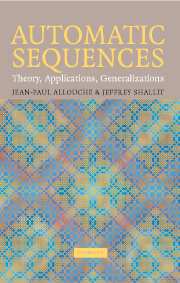Book contents
- Frontmatter
- Contents
- Preface
- 1 Stringology
- 2 Number Theory and Algebra
- 3 Numeration Systems
- 4 Finite Automata and Other Models of Computation
- 5 Automatic Sequences
- 6 Uniform Morphisms and Automatic Sequences
- 7 Morphic Sequences
- 8 Frequency of Letters
- 9 Characteristic Words
- 10 Subwords
- 11 Cobham's Theorem
- 12 Formal Power Series
- 13 Automatic Real Numbers
- 14 Multidimensional Automatic Sequences
- 15 Automaticity
- 16 k-Regular Sequences
- 17 Physics
- Appendix Hints, References, and Solutions for Selected Exercises
- Bibliography
- Index
3 - Numeration Systems
Published online by Cambridge University Press: 13 October 2009
- Frontmatter
- Contents
- Preface
- 1 Stringology
- 2 Number Theory and Algebra
- 3 Numeration Systems
- 4 Finite Automata and Other Models of Computation
- 5 Automatic Sequences
- 6 Uniform Morphisms and Automatic Sequences
- 7 Morphic Sequences
- 8 Frequency of Letters
- 9 Characteristic Words
- 10 Subwords
- 11 Cobham's Theorem
- 12 Formal Power Series
- 13 Automatic Real Numbers
- 14 Multidimensional Automatic Sequences
- 15 Automaticity
- 16 k-Regular Sequences
- 17 Physics
- Appendix Hints, References, and Solutions for Selected Exercises
- Bibliography
- Index
Summary
In this chapter, we discuss how numbers can be represented by strings over a finite alphabet. Our emphasis is on the representation of integers, although we briefly discuss representations for real numbers in Section 3.4.
We start with the classical base-k representation, and then discuss less familiar representations such as representation in base —k, Fibonacci representation, and representation in complex bases.
Numeration Systems
A numeration system is a way of expressing an integer n (or, more generally, an element of a given semiring S) as a finite linear combination of base elements ui. The ai are called the generalized digits, or just digits. The finite string of digits arar-1 … a1a0 is then said to be a representation of the number n. Note that our convention is to write representations starting with the most significant digit, although admittedly this choice is somewhat arbitrary.
For example, in ordinary decimal notation the base elements are the powers of 10. As is certainly familiar to most readers, every non-negative integer can be expressed as a non-negative integer linear combination with 0 ≤ ai < 10.
The leading-zeros problem is a minor annoyance we must deal with. For example, each of the strings 101, 0101, 00101, … is a different way to express the number 5 in base 2.
Information
- Type
- Chapter
- Information
- Automatic SequencesTheory, Applications, Generalizations, pp. 70 - 127Publisher: Cambridge University PressPrint publication year: 2003
Accessibility standard: Unknown
Why this information is here
This section outlines the accessibility features of this content - including support for screen readers, full keyboard navigation and high-contrast display options. This may not be relevant for you.Accessibility Information
- 1
- Cited by
